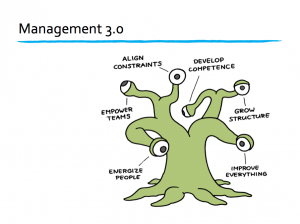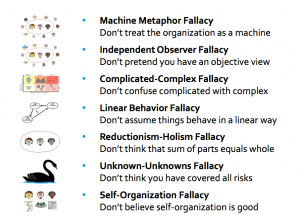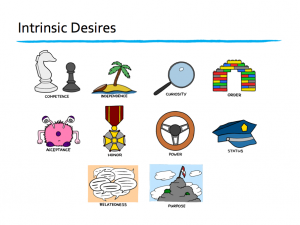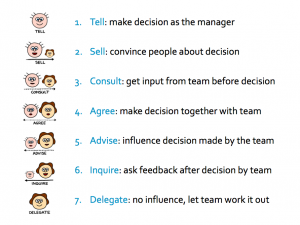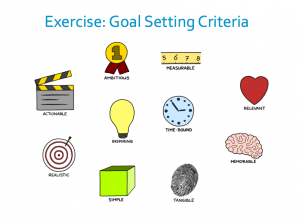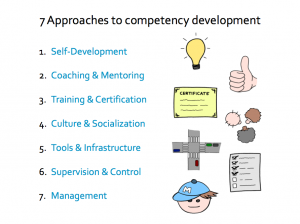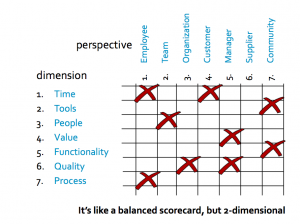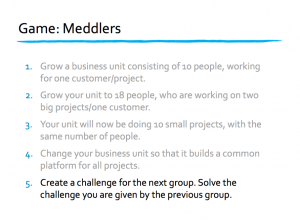Lean startup experiment, phase 2: building the MVP
24 de agosto, 2011Pick your battles
1 de setembro, 2011I mentioned earlier that one of the sources I’ve been reading and enjoying is Jurgen Appelo’s posts about agile management. I’ve been reading his posts for a while, since the time he was the CTO of a dutch company. I really like the way he connects agile methodologies and complex adaptive systems theory.
I’ve mentioned his work in 4 posts:
- Liderança flexível (Dec/2008 – in Portuguese)
- Agile management (Mar/2011)
- Delegation levels (Apr/2011)
- Leading is similar to being a doctor (Apr/2011)
Now he is 100% focused on his agile management coach career. He recently launched a book entitled “Management 3.0: Leading Agile Developers, Developing Agile Leaders“.
He also provides Agile Management courses.
Last week he was in São Paulo providing his management course at AdaptWorks and I had the opportunity to attend his course.
I’ll make a brief summary of the course below, as a way for me to review what we discussed during this two days. However, I strongly advise any leader, even from non software related areas or companies, to attend. Even though the ideas and insights Jurgen provides during the course are very good and he is an excellent presenter, you can read them in his blog and in his book. What is great in this course is the opportunity to practice and discuss the ideas and insights with Jurgen and the other attendees and the chance to exchange experiences.
Intro
After a quick introduction about the ideal size of a group and quick introductions of the attendees, Jurgen explained quickly about agile software development and then introduced Martie, the Management 3.0 representation with the 6 aspects of management that we should take care if we want to be good managers.
Then Jurgen explained briefly about the theory of complex systems and the types of fallacies we may fall into if we don’t use complex systems thinking when managing teams.
To end the introductory section, we did a group exercise where we analyzed some situations to identify what was the fallacy in play.
Energize people
When discussing about people, Jurgen talked about intrinsic and extrinsic motivation and presented us with the 10 intrinsic desires:
- Acceptance The need for approval
- Curiosity The need to think
- Power The need for influence of will
- Honor Being loyal to a group
- Social Contact / Relatedness The need for friends
- Idealism / Purpose The need for purpose
- StatusThe need for social standing
- Independence / Autonomy Being an individual
- Order Or stable environments
- Competence / Mastery The need to feel capable
Exercise time: we analyzed individually how we are in our current jobs in terms of each of these 10 intrinsic desires.
Then Jurgen presented some tools to helps us know what is important for the people in our team:
- One-to-one (1-2-1) meetings
- MBTI assessments
- 16PF assessments
- Happines index
- Gallup’s 12 questions
- Pair working
- 360 degree evaluations
- Social networks
- “Dinner parties”
- “Community events”
- “Sauna”
- “Water cooler talks”
Group exercise: we had to use the practices below to get to know 10 important facts about Ellen, a member of a fictional team managed by us.
Empower teams
Here Jurgen presented the 7 delegation levels I already mentioned in a previous post.
Group exercise: delegation poker where we were presented with different situations where we needed to figure out the appropriate delegation level.
Align constraints
A leader must:
- define the constraints (playing field, players), but let the system create its own rules.
- protect people against bad team formation
- protect good teams against non-team players
- protect shared resources (energy, budget, environment, office space, food, sysadmins)
The 4 I’s to cope with the Tragedy of the Commons:
- Institutions: create trust to accept common rules
- Information: increase understanding of situation
- Identity: increase social belonging across teams
- Incentives: address behaviors with small rewards
3 kinds of purpose (or goal) for a team:
- Intrinsic purpose: an easily spottable trend in a team, e.g., produce software.
- Extrinsic purpose: assigned by caretaker, e.g., make money.
- Emergent purpose: chosen by the team, e.g., be a winning team.
Exercise time: we had to define a purpose for the course.
Develop competence
First Jurgen described how we can improve.
Then he described how we can measure our improvement.
Exercise time: we had to define KPIs according to the matrix above to our organization.
Grow structure
We can have two types of team organization, functional or cross-functional, it depends on how often team members need to communicate. Product managers, user experience designers and software developers need to communicate all the time about the project or product they are working on, so they need to sit together in a cross functional team. HR people on the other hand need to talk constantly to other HR people so they need to sit in a functional HR team.
Jurgen also advised we should hire generalizing specialists, promote informal leadership and widen job titles.
Exercise time: Meddlers.
Improve everything
How can I…
- Make the rest of the organization more Agile?
- Motivate my employees to develop themselves?
- Convince customers they should accept Scrum?
- Etc…
In order to change things we need to consider:
The system
- Plan: What Is Your Goal?
- Plan: Where Is It Going Well?
- Do: What Are the Crucial Steps?
- Do: When and Where Do You Start?
- Check: How Do You Measure Results?
- Check: How Do You Get Feedback?
- Act: How Do You Accellerate Results?
The individuals
- Awareness: How Will You Communicate?
- Awareness: How Will You Set an Example?
- Desire: How Do You Make It Urgent?
- Desire: How Do You Make It Desirable?
- Knowledge: What Will You Tell Them?
- Knowledge: Who Will Be Teaching?
- Ability: What Makes It Easy?
- Ability: How Can They Practice?
- Reinforcement: What Are the Short-Term Wins?
- Reinforcement: What Makes It Sustainable?
The interactions
- Initiators: Are You Committed?
- Initiators: Who Is Assisting You?
- Innovators: Who Will Be the Innovators?
- Early Adopters: Who Are the Early Adopters?
- Early Adopters: How Will the Leaders Help?
- Early Majority: How Do You Reach the Early Majority?
- Early Majority: How Will You Cross the Chasm?
- Late Majority: How Will You Deal with Skeptics?
- Laggards: How Do You Prevent a Relapse?
- Laggards: How Do You Deal with Resistance?
The environment
- Information: How Do You Make Things Visible?
- Information: How Do You Ease Communication?
- Identity: What Is the Group Identity?
- Identity: How Can You Apply Peer Pressure?
- Incentives: Can You Incentivize Good Behavior?
- Infrastructure: Which Barriers Will You Remove?
- Infrastructure: Which Guides Will You Place?
- Institutions: Who Can Make the Rules?
Culture changes only after you have successfully altered people’s actions, after the new behavior produces some group benefit for a period of time.
John P. Kotter, Leading Change
Exercise time: each member of the group tell one story with she needs ideas on how to change, then the group select from the list above and discuss.
Conclusion
This is just a brief summary of the 2-day course, as a way for me to review what we discussed during. However, I strongly advise any leader, even from non software related areas or companies, to attend. Even though the ideas and insights Jurgen provides during the course are very good and he is an excellent presenter, you can read them in his blog and in his book. What is great in this course is the opportunity to practice and discuss the ideas and insights with Jurgen and the other attendees and the chance to exchange experiences.

